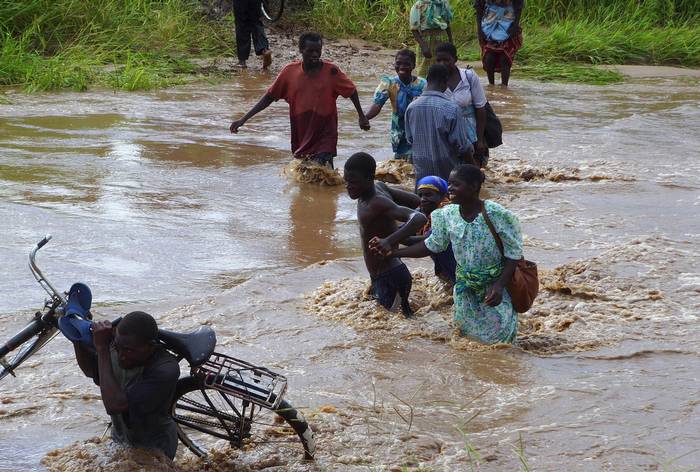As wild weather worsens, Malawi forecasting gets a $16 mln makeover
- 19/10/2017

In this 2008 file photo, people cross a flooded river in Chikwawa district, some 70 km (43 miles) south of Malawi's commercial capital Blantyre. REUTERS/Eldson Chagara

MZUZU, Malawi – In a bid to help farmers cope with more extreme weather, Malawi has launched a $16 million effort to update weather stations and provide more accurate forecasts, officials say.
Backed with $12 million from the international Green Climate Fund and $4 million from Malawi’s government, the push will pay for installation of automated weather stations in 21 districts around the country and new software to turn data collected into more accurate short-term weather and longer-term climate forecasts.
The changes are expected to improve the accuracy of Malawi’s forecasts by 80 percent, and allow real-time monitoring of rainfall, which could help improve early warning alerts, said Clement Chinthu Phiri, Malawi’s commissioner for disaster management affairs.
The funding will also help better train forecasters, including in how to issue reports that are easier for farmers to understand and use, and pay for creation of a mobile phone app to provide forecasts in local languages.
Up to now, Malawi has suffered from a lack of weather data and too few people trained “to operate and maintain climate information and early warning systems” said Mphanda Kabwazi, a disaster risk expert with the U.N. Development Programme, one of the backers of the Malawi initiative.
The country has focused more on relief and rehabilitation after weather-related disasters, from floods to droughts, rather than preparing for them, she said.
The lack of good information has hurt efforts to adapt to changing conditions as a result of climate change, and has handicapped efforts to provide effectively early warnings about disaster risks, she said.
Under the improved forecasting system, however, easier-to-use information should flow to farmers, fishermen and other potential users through everything from community radio stations to social media platforms, Kabwazi said.
Malawi has suffered worsening problems with droughts and flooding in recent years. In 2015 floods killed over 100 people and displaced 300,000, and recent droughts worsened by the El Nino phenomenon have handicapped government pushes to improve food security and increase agricultural production.
The new M-CLIMES effort will be led by Malawi’s Department of Disaster Management Affairs (DODMA), with support from agencies focused on climate change and meteorology, water resources, fisheries, and agricultural extension, as well as backing from the National Small Holder Farmers Association.
MORE STATIONS, BETTER ADVISORIES
Stern Kita, a DODMA official, said the programme’s first phase will focus on the installation of 32 automatic weather stations and two special weather observing systems for Kamuzu International Airport and Chileka Aviation Station, the two major airports in the country.
It will also link the new information being collected to district climate information centres and 11 rural community radio stations, as well as Malawi’s national broadcaster.
The country’s water department will also see its 37 hydrological stations begin storing data digitally, and new monitoring stations set up. The fisheries department will get help producing tailored weather advisories for each district, focused on wind and waves and including information about survival at sea, Kita told the Thomson Reuters Foundation.
Agricultural extension workers will be trained on how to interpret and use SMS messages as part of the effort, and NASFAM, the farmers’ organisation, expects to train more than 60 field officers and 1,400 farmers on how to use the weather and climate information that is distributed.
Fred Kossam, Malawi’s chief meteorologist, said the country’s weather observation network has been in decline for the last two or three decades – one reason the new push is needed.
Sophie Makoloma, of the Enhancing Community Resilience Programme in Malawi under charity Christian Aid, called the new weather information push an important contribution to the country’s climate resilience strategy, though said it would need to be incorporated with other efforts to be effective.
Andrew Saukani, a lecturer at Mpwepwe Fisheries College, similarly said that creating new awareness about climate risks is key in Malawi, but “this must translate into action since climate change and global warming are here to stay.”
Video
From camel to cup
From Camel to Cup' explores the importance of camels and camel milk in drought ridden regions, and the under-reported medicinal and vital health benefits of camel milk
Blogs
As climate risks rise, insurance needed to protect development
Less than 5 percent of disaster losses are covered by insurance in poorer countries, versus 50 percent in rich nations
Disasters happen to real people – and it's complicated
Age, gender, ethnicity, sexual orientation and many more factors must be considered if people are to become resilient to climate extremes
NGOs are shaking up climate services in Africa. Should we be worried?
A concern is around the long-term viability of hard-fought development gains
The paradox of water development in Kenya's drylands
In Kenya's Wajir county, the emphasis on water development is happening at the expense of good water governance












We welcome comments that advance the story through relevant opinion, anecdotes, links and data. If you see a comment that you believe is irrelevant or inappropriate, you can flag it to our editors by using the report abuse links. Views expressed in the comments do not represent those of Braced or its partners.